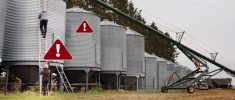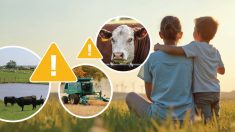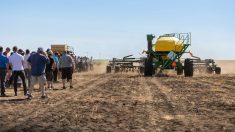Spring is coming and western Canadian farms are about to explode into motion to get livestock on pasture and the 2025 crop in the ground.
Farm safety experts, however, urge farm families not to lose sight of safety — particularly when it comes to their kids — during the flurry of activity.
Why it matters: Canadian Agricultural Safety Week, which runs March 16-22 this year, hopes to inspire farmers to take a sober second look at their practices, even during the spring seeding rush.
Read Also

Seeding Indigenous agricultural prosperity
National Circle for Indigenous Agriculture and Food says Indigenous agricultural success needs strong relationships.
Farming is a relatively dangerous professsion. The Canadian Agricultural Injury Reporting (CAIR) project (an initiative from the Canadian Agricultural Safety Association) puts ag-related deaths at 62 a year.
It’s been on a general downtrend, reports from the association note. Of those deaths though, 11 per cent were farm children and, according to a 2023 CAIR report, children from one to four-years-old posted the highest fatality rates of any age category under 20 from 1990-2020.
The same report noted than more than 400 children were killed in agriculture-related incidents from 1990 to 2020. Continentally, the National Children’s Center for Rural and Agricultural Health and Safety in the U.S. reports that more than 100 children are killed and 32,800 seriously injured on farms each year in North America.
“We know that the majority of children and youth agriculture-related incidents resulting in death are because of runovers, drowning and collision-related incidents,” said Robin Anderson, CASA director of programs and communications.

Safe farm involvement for kids
There are many hazards on the average farm, ranging from vehicles, machinery and big — temptingly climbable — structures like bins and bales, to livestock, ag chemical exposure, dugouts and ditches. Natural curiosity can lead to risky behaviour around those hazards.
For farm kids, it’s not just their parents’ place of work. The farm is home.
There is also a desire among farm families to get kids involved in the family business, in ways appropriate to their age. Farmers will point to that as key to developing their children’s interest in the farm young and helping to cement farm succession when it comes time pass the operation down to the next generation.
Those children can still feel included and useful on the farm while being kept safe, organizations like CASA argue. Children can take part in the safer farm responsibilities and can be eased into more advanced tasks in controlled environments, with supervision, as they get older and different activities become appropriate for their age.
When deciding whether a child is physically and mentally ready to take on farm tasks, parents and guardians are encouraged to consult the Agricultural Youth Work Guidelines on the CASA website, Anderson said.
“The Agricultural Youth Work Guidelines are designed to help adults assess a youth’s abilities to safely perform a task and assign age and ability-appropriate tasks to youth working in agriculture, helping to prevent injuries and fatalities.”
Each guideline outlines the skills a youth must have to safely perform a task, the responsibilities of adults in supervising them, and key hazards along with protective strategies. These guidelines can also serve as a resource for supervisors and youth when discussing task safety, conducting in-person training, and can be displayed as posters to remind employers, supervisors, and workers of the importance of maintaining a safe work environment.
CASA also urges producers not to rush youth into farm work, especially less supervised farm work, until they are ready. While children one to four years made up the biggest fatality numbers in CAIR’s child fatality reporting, the second highest category, in terms of gross numbers, was youth aged 15-19 years.
About 33 per cent of youth and child deaths CAIR reported between 1990-2020 involved the victim working at the time.
“Children aren’t miniature adults. Although many farm children are very smart and savvy, it’s important to remember that they are still children,” Anderson said.
Safe tasks for younger children could include pulling weeds or planting garden seeds, the association notes.

Learning farm safety
The association also notes that children will mimic their parents’ behaviour and attitudes when it comes to farm safety. They urge parents to model safe behaviors and foster a safety-conscious mindset. Safety can be framed as a two-way discussion with children, encouraging them to speak up about potential hazards.
Children working with livestock also face significant risks.
“Children should not be handling aggressive or unpredictable animals,” Anderson said
She again pointed farm parents to the Agricultural Youth Work Guidelines for best practices when interacting with farm animals.
Properly labelling, storing and securing pesticides, fertilizers and other farm chemicals in designated areas that are off-limits to children can help keep them safe, CASA says. Grain bins, silos and manure pits should also be restricted to authorized persons only to prevent accidents.
“Making these areas off-limits to unauthorized persons, including children, go a long way in preventing unintentional consequences,” Anderson said.
Farm safety experts also advise parents to teach younger children about farm hazards early. Those can be simple conversations about dangerous areas. As they grow older, Anderson suggests using the work guidelines to facilitate discussions on safety, training and supervision.
Farm safety plan
Every farm is unique, so first-aid kits should be tailored to the specific risks present. Families should assess their farm layout and potential hazards when assembling first-aid supplies. They should also regularly discuss emergency procedures, including how to call for help and provide responders with clear directions.
Above all, parents should be role models and maintain open communication with their children about farm hazards to foster a safety-conscious mindset, Anderson said.
















